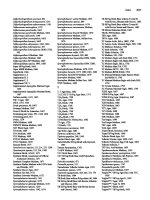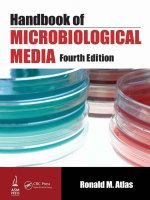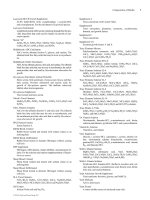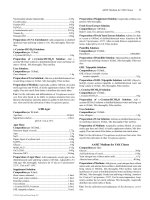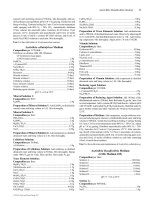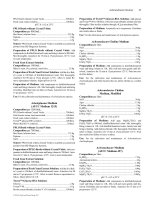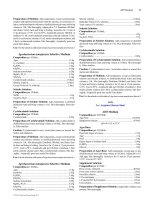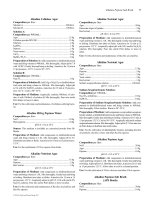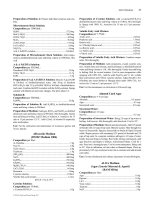Handbook of Microbiological Media, Fourth Edition part 83 ppsx
Bạn đang xem bản rút gọn của tài liệu. Xem và tải ngay bản đầy đủ của tài liệu tại đây (233.78 KB, 10 trang )
Heart Infusion Broth with Human Serum and Fresh Yeast Extract 815
Preparation of Glucose Solution: Add D-glucose to distilled/de-
ionized water and bring volume to 10.0mL. Mix thoroughly. Filter ster-
ilize.
Preparation of Medium: Add components, except antibiotic inhibitor
solution and glucose solution, to distilled/deionized water and bring vol-
ume to 980.0mL. Mix thoroughly. Gently heat and bring to boiling. Auto-
clave for 15 min at 15 psi pressure–121°C. Cool to 45°–50°C. Aseptically
add sterile antibiotic inhibitor solution and glucose solution. Mix thor-
oughly. Aseptically distribute into sterile tubes or flasks.
Use: For the cultivation of Escherichia coli.
Heart Infusion Broth, HiVeg
Composition per liter:
Plant hydrolysate No. 1 10.0g
Plant infusion 10.0g
NaCl 5.0g
pH 7.4 ± 0.2 at 25°C
Source: This medium is available as a premixed powder from Hi-
Media.
Preparation of Medium: Add components to distilled/deionized
water and bring volume to 1.0L. Mix thoroughly. Gently heat and bring
to boiling. Distribute into tubes or flasks. Autoclave for 15 min at 15
psi pressure–121°C.
Use: For the isolation and cultivation of a wide variety of fastidious
microorganisms.
Heart Infusion Broth
with Horse Serum and Fresh Yeast Extract
Composition per 930.0mL:
Heart infusion broth 720.0mL
Horse serum, unheated 200.0mL
Fresh yeast extract solution 10.0mL
pH 7.4 ± 0.2 at 25°C
Heart Infusion Broth:
Composition
per liter:
Beef heart, infusion from 500.0g
Tryptose 10.0g
NaCl 5.0g
Preparation of Heart Infusion Broth: Add components to dis-
tilled/deionized water and bring volume to 1.0L. Mix thoroughly. Au-
toclave for 15 min at 15 psi pressure–121°C. Cool to 45°–50°C.
Fresh Yeast Extract Solution:
Composition
per 100.0mL:
Baker’s yeast, live, pressed, starch-free 25.0g
Preparation of Fresh Yeast Extract Solution: Add the live Bak-
er’s yeast to 100.0mL of distilled/deionized water. Autoclave for 90
min at 15 psi pressure–121°C. Allow to stand. Remove supernatant so-
lution. Adjust pH to 6.6–6.8.
Preparation of Medium: To 720.0mL of sterile cooled heart infu-
sion broth, aseptically add 200.0mL of horse serum and 10.0mL of
fresh yeast extract solution. Mix thoroughly. Aseptically distribute into
sterile tubes or flasks.
Use: For the cultivation and maintenance of Mycoplasma equigenita-
lium and Mycoplasma subdolum.
Heart Infusion Broth with Horse Serum, Fresh Yeast
Extract, and Penicillin
Composition per 940.0mL:
Heart infusion broth 720.0mL
Horse serum, unheated 200.0mL
Fresh yeast extract solution 10.0mL
Penicillin solution 10.0mL
pH 7.4 ± 0.2 at 25°C
Heart Infusion Broth:
Composition
per liter:
Beef heart, infusion from 500.0g
Tryptose 10.0g
NaCl 5.0g
Preparation of Heart Infusion Broth: Add components to dis-
tilled/deionized water and bring volume to 1.0L. Mix thoroughly. Au-
toclave for 15 min at 15 psi pressure–121°C. Cool to 45°–50°C.
Fresh Yeast Extract Solution:
Composition
per 100.0mL:
Baker’s yeast, live, pressed, starch-free 25.0g
Preparation of Fresh Yeast Extract Solution: Add the live Bak-
er’s yeast to 100.0mL of distilled/deionized water. Autoclave for 90
min at 15 psi pressure–121°C. Allow to stand. Remove supernatant so-
lution. Adjust pH to 6.6–6.8.
Penicillin Solution:
Composition
per 10.0mL:
Penicillin 100,000U
Preparation of Penicillin Solution: Add penicillin to distilled/de-
ionized water and bring volume to 10.0mL. Mix thoroughly. Filter ster-
ilize.
Preparation of Medium: To 720.0mL of sterile cooled heart infusion
broth, aseptically add 200.0mL of horse serum, 10.0mL of fresh yeast ex-
tract solution, and 10.0mL of sterile penicillin solution. Mix thoroughly.
Aseptically distribute into sterile tubes or flasks.
Use: For the cultivation and maintenance of Mycoplasma equigenita-
lium and Mycoplasma subdolum.
Heart Infusion Broth with Human
Serum and Fresh Yeast Extract
Composition per 930.0mL:
Heart infusion broth 720.0mL
Human serum, unheated 200.0mL
Fresh yeast extract solution 10.0mL
pH 7.4 ± 0.2 at 25°C
Heart Infusion Broth:
Composition
per liter:
Beef heart, infusion from 500.0g
Tryptose 10.0g
NaCl 5.0g
Preparation of Heart Infusion Broth: Add components to dis-
tilled/deionized water and bring volume to 1.0L. Mix thoroughly. Au-
toclave for 15 min at 15 psi pressure–121°C. Cool to 45°–50°C.
Fresh Yeast Extract Solution:
Composition
per 100.0mL:
Baker’s yeast, live, pressed, starch-free 25.0g
Preparation of Fresh Yeast Extract Solution: Add the live Bak-
er’s yeast to 100.0mL of distilled/deionized water. Autoclave for 90
© 2010 by Taylor and Francis Group, LLC
816 Heart Infusion Broth with Inactivated Horse Serum
min at 15 psi pressure–121°C. Allow to stand. Remove supernatant so-
lution. Adjust pH to 6.6–6.8.
Preparation of Medium: To 720.0mL of sterile, cooled heart infu-
sion broth, aseptically add 200.0mL of human serum and 10.0mL of
fresh yeast extract solution. Mix thoroughly. Aseptically distribute into
sterile tubes or flasks.
Use: For the cultivation and maintenance of Mycoplasma equigenita-
lium and Mycoplasma subdolum.
Heart Infusion Broth
with Inactivated Horse Serum
Composition per liter:
Beef heart, infusion from 500.0g
Tryptose 10.0g
NaCl 5.0g
Horse serum, inactivated 100.0mL
pH 7.6 ± 0.2 at 25°C
Preparation of Medium: Add components, except horse serum, to
distilled/deionized water and bring volume to 900.0mL. Mix thorough-
ly. Gently heat and bring to boiling. Autoclave for 15 min at 15 psi
pressure–121°C. Cool to 45°–50°C. Aseptically add sterile horse se-
rum. Mix thoroughly. Aseptically distribute into sterile tubes or flasks.
Use: For the cultivation and maintenance of Enterococcus faecium.
Heart Infusion Broth with Inactivated Horse Serum
and Fresh Yeast Extract
Composition per liter:
Beef heart, infusion from 500.0g
Tryptose 10.0g
NaCl 5.0g
Horse serum, inactivated 200.0mL
Fresh yeast extract solution 100.0mL
pH 7.5 ± 0.2 at 25°C
Source: This medium is available as a premixed powder from BD Di-
agnostic Systems.
Fresh Yeast Extract Solution:
Composition
per 100.0mL:
Baker’s yeast, live, pressed, starch-free 25.0g
Preparation of Fresh Yeast Extract Solution: Add the live Bak-
er’s yeast to 100.0mL of distilled/deionized water. Autoclave for 90
min at 15 psi pressure–121°C. Allow to stand. Remove supernatant so-
lution. Adjust pH to 6.6–6.8.
Preparation of Medium: Add components, except horse serum and
fresh yeast extract solution, to distilled/deionized water and bring volume
to 700.0mL. Mix thoroughly. Gently heat and bring to boiling. Autoclave
for 15 min at 15 psi pressure–121°C. Cool to 45°–50°C. Aseptically add
sterile horse serum and fresh yeast extract solution. Mix thoroughly. Asep-
tically distribute into sterile tubes or flasks.
Use: For the cultivation and maintenance of Acholeplasma species,
Mycoplasma species, and Streptobacillus species.
Heart Infusion Broth with Inactivated Horse Serum,
Fresh Yeast Extract, and Sucrose
Composition per liter:
Beef heart, infusion from 500.0g
Sucrose 40.0g
Tryptose 10.0g
NaCl 5.0g
Horse serum, inactivated 200.0mL
Fresh yeast extract solution 100.0mL
pH 7.5 ± 0.2 at 25°C
Source: This medium is available as a premixed powder from BD Di-
agnostic Systems.
Fresh Yeast Extract Solution:
Composition
per 100.0mL:
Baker’s yeast, live, pressed, starch-free 25.0g
Preparation of Fresh Yeast Extract Solution: Add the live Bak-
er’s yeast to 100.0mL of distilled/deionized water. Autoclave for 90
min at 15 psi pressure–121°C. Allow to stand. Remove supernatant so-
lution. Adjust pH to 6.6–6.8.
Preparation of Medium: Add components, except horse serum and
fresh yeast extract solution, to distilled/deionized water and bring volume
to 700.0mL. Mix thoroughly. Gently heat and bring to boiling. Autoclave
for 15 min at 15 psi pressure–121°C. Cool to 45°–50°C. Aseptically add
sterile horse serum and fresh yeast extract solution. Mix thoroughly. Asep-
tically distribute into sterile tubes or flasks.
Use: For the cultivation and maintenance of Acholeplasma species,
Mycoplasma species, and Streptobacillus species.
Heart Infusion Broth (pH 7.5) with Inactivated
Human Serum and Yeast Extract
(ATCC Medium 245)
Composition
per liter:
Heart infusion broth with yeast extract 800.0mL
Human serum, inactivated 200.0mL
pH 7.5 ± 0.2 at 25°C
Heart Infusion Broth with Yeast Extract:
Composition
per liter:
Beef heart, infusion from 500.0g
Tryptose 10.0g
Yeast extract (Oxoid) 6.3g
NaCl 5.0g
Preparation of Heart Infusion Broth with Yeast Extract:
Add components to distilled/deionized water and bring volume to
1.0L. Mix thoroughly. Adjust pH to 7.5. Autoclave for 15 min at 15 psi
pressure–121°C. Cool to 25°.
Source: Heart infusion broth without yeast extract is available as a
premixed powder from BD Diagnostic Systems.
Preparation of Medium: To 800.0mL of sterile cooled heart infu-
sion broth with yeast extract, aseptically add 200.0mL of heat inacti-
vated human serum. Mix thoroughly. Aseptically distribute into sterile
tubes or flasks.
Use: For the cultivation and maintenance of Corynebacterium pseudo-
tuberculosis and Streptobacillus moniliformis.
Heart Infusion Broth with Porcine
Serum and Fresh Yeast Extract
Composition per liter:
Beef heart, infusion from 500.0g
Tryptose 10.0g
NaCl 5.0g
Porcine serum, inactivated 200.0mL
Fresh yeast extract (25% w/v solution) 100.0mL
pH 7.5 ± 0.2 at 25°C
© 2010 by Taylor and Francis Group, LLC
Hektoen Enteric Agar 817
Porcine Serum:
Composition
per 200.0mL:
Porcine serum 200.0mL
Preparation of Porcine Serum: Adjust the pH of 200.0mL of por-
cine serum to 4.4 with sterile 1N HCl. Do not overshoot pH below 4.2.
Allow serum to stand at 4°C for 18–20 hr. Adjust pH to 7.0 with sterile
NaOH. Aseptically centrifuge at 9000 rpm for 20 min. Discard sedi-
ment. Filter supernatant solution through a 0.85μm filter. Filter steril-
ize through a 0.22μm filter. Store at −70°C.
Fresh Yeast Extract Solution:
Composition
per 100.0mL:
Baker’s yeast, live, pressed, starch-free 25.0g
Preparation of Fresh Yeast Extract Solution: Add the live Bak-
er’s yeast to 100.0mL of distilled/deionized water. Autoclave for 90
min at 15 psi pressure–121°C. Allow to stand. Remove supernatant so-
lution. Adjust pH to 6.6–6.8.
Preparation of Medium: Add components, except porcine serum and
fresh yeast extract solution, to distilled/deionized water and bring volume
to 700.0mL. Mix thoroughly. Gently heat and bring to boiling. Autoclave
for 15 min at 15 psi pressure–121°C. Cool to 45°–50°C. Aseptically add
sterile porcine serum and fresh yeast extract solution. Mix thoroughly.
Aseptically distribute into sterile tubes or flasks.
Use: For the cultivation of Acholeplasma species.
Heart Infusion Broth with Sodium Chloride
(HI with NaCl)
(BAM M60)
Composition per liter:
NaCl 20.0g
Tryptose 10.0g
NaCl 20.0g
Beef heart, infusion from 500.0g 1.0L
pH 7.4 ± 0.2 at 25°C
Source: This medium without added NaCl is available as a premixed
powder from BD Diagnostic Systems.
Preparation of Medium: Add components to distilled/deionized
water and bring volume to 1.0L. Mix thoroughly. Distribute into tubes
or flasks. Autoclave for 15 min at 15 psi pressure–121°C.
Use: For the isolation and cultivation of halophilic Vibrio spp.
Heart Infusion Medium with Fetal Bovine Serum
Composition per liter:
Beef heart, infusion from 500.0g
Agar 15.0g
Tryptose 10.0g
NaCl 5.0g
Fetal bovine serum 100.0mL
pH 7.4 ± 0.2 at 25°C
Preparation of Medium: Add components, except fetal bovine se-
rum, to distilled/deionized water and bring volume to 900.0mL. Mix
thoroughly. Gently heat and bring to boiling. Autoclave for 15 min at
15 psi pressure–121°C. Cool to 45°–50°C. Aseptically add sterile fetal
bovine serum. Aseptically distribute into sterile tubes or flasks.
Use: For the cultivation of Haemophilus ducreyi.
Heart Infusion Tyrosine Agar
Composition per liter:
Beef heart, infusion from 500.0g
Agar 15.0g
Tryptose 10.0g
NaCl 5.0g
L-Tyrosine 1.0g
pH 7.4 ± 0.2 at 25°C
Preparation of Medium: Add components to distilled/deionized
water and bring volume to 1.0L. Mix thoroughly. Gently heat and bring
to boiling. Distribute into tubes. Autoclave for 15 min at 15 psi pres-
sure–121°C. Allow tubes to cool in a slanted position.
Use: For the cultivation and differentiation of Bordetella parapertus-
sis based on browning of blood-free medium.
Hektoen Enteric Agar
Composition per liter:
Agar 13.5g
Lactose 12.0g
Peptic digest of animal tissue 12.0g
Sucrose 12.0g
Bile salts 9.0g
NaCl 5.0g
Na
2
S
2
O
3
5.0g
Yeast extract 3.0g
Salicin 2.0g
Ferric ammonium citrate 1.5g
Acid Fuchsin 0.1g
Bromthymol Blue 0.064g
pH 7.6 ± 0.2 at 25°C
Source: This medium is available as a premixed powder from BD Di-
agnostic Systems and Oxoid Unipath.
Caution: Acid Fuchsin is a potential carcinogen and care must be tak-
en to avoid inhalation of the powdered dye and contact with the skin.
Preparation of Medium: Add components to distilled/deionized
water and bring volume to 1.0L. Mix thoroughly. Gently heat while
stirring until components are dissolved. Do not autoclave. Pour into
sterile Petri dishes. Allow agar to solidify with the Petri dish covers
partially off.
Use: For the isolation and cultivation of Gram-negative enteric micro-
organisms from a variety of clinical and nonclinical specimens based
on lactose or sucrose fermentation and H
2
S production. For the isola-
tion and differentiation of Salmonella and Shigella. Bacteria that fer-
ment lactose or sucrose appear as yellow to orange colonies. Bacteria
that produce H
2
S appear as colonies with black centers.
Hektoen Enteric Agar
Composition per liter:
Agar 15.0g
Proteose peptone 12.0g
Lactose 12.0g
Sucrose 12.0g
Bile salts 9.0g
NaCl 5.0g
Na
2
S
2
O
3
5.0g
Yeast extract 3.0g
Salicin 2.0g
Ferric ammonium citrate 1.5g
© 2010 by Taylor and Francis Group, LLC
818 Hektoen Enteric Agar, HiVeg
Acid Fuchsin 0.1g
Bromthymol Blue 0.065g
pH 7.5 ± 0.2 at 25°C
Source: This medium is available as a premixed powder from Hi-
Media.
Caution: Acid Fuchsin is a potential carcinogen and care must be tak-
en to avoid inhalation of the powdered dye and contact with the skin.
Preparation of Medium: Add components to distilled/deionized
water and bring volume to 1.0L. Mix thoroughly. Gently heat while
stirring until components are dissolved. Do not autoclave. Pour into
sterile Petri dishes. Allow agar to solidify with the Petri dish covers
partially off.
Use: For the isolation and cultivation of Gram-negative enteric micro-
organisms from a variety of clinical and nonclinical specimens based
on lactose or sucrose fermentation and H
2
S production. For the isola-
tion and differentiation of Salmonella and Shigella. Bacteria that fer-
ment lactose or sucrose appear as yellow to orange colonies. Bacteria
that produce H
2
S appear as colonies with black centers.
Hektoen Enteric Agar, HiVeg
Composition per liter:
Plant peptone No. 3 19.0g
Agar 15.0g
Lactose 12.0g
Sucrose 12.0g
NaCl 5.0g
Na
2
S
2
O
3
5.0g
Yeast extract 3.0g
Synthetic detergent No. I 2.0g
Salicin 2.0g
Ferric ammonium citrate 1.5g
Acid Fuchsin 0.1g
Bromthymol Blue 0.065g
pH 7.5 ± 0.2 at 25°C
Source: This medium is available as a premixed powder from Hi-
Media.
Caution: Acid Fuchsin is a potential carcinogen and care must be tak-
en to avoid inhalation of the powdered dye and contact with the skin.
Preparation of Medium: Add components to distilled/deionized
water and bring volume to 1.0L. Mix thoroughly. Gently heat while
stirring until components are dissolved. Do not autoclave. Pour into
sterile Petri dishes. Allow agar to solidify with the Petri dish covers
partially off.
Use: For the isolation and cultivation of Gram-negative enteric micro-
organisms from a variety of clinical and nonclinical specimens based
on lactose or sucrose fermentation and H
2
S production. For the isola-
tion and differentiation of Salmonella and Shigella. Bacteria that fer-
ment lactose or sucrose appear as yellow to orange colonies. Bacteria
that produce H
2
S appear as colonies with black centers.
Helicobacter Medium
Composition per 850.0mL:
Agar 15.0g
Beef extract 10.0g
Peptone 10.0g
NaCl 5.0g
Horse blood, laked 50.0mL
Antibiotic solution A 10.0mL
Antibiotic solution B 10.0mL
pH 7.3 ± 0.2 at 25°C
Antibiotic Solution A:
Composition
per 10.0mL:
Vancomycin 1.0mg
Trimethoprim 5.0mg
Polymyxin B 250 U
Preparation of Antibiotic Solution A: Add components to dis-
tilled/deionized water and bring volume to 10.0mL. Mix thoroughly.
Filter sterilize.
Antibiotic Solution B:
Composition
per 10.0mL:
Amphotericin B 5.0mg
Dimethylformamide 2.0mL
Preparation of Antibiotic Solution B: Add components to dis-
tilled/deionized water and bring volume to 10.0mL. Mix thoroughly.
Filter sterilize.
Preparation of Medium: Add components, except laked horse
blood, antibiotic solution A, and antibiotic solution B, to distilled/de-
ionized water and bring volume to 930.0mL. Mix thoroughly. Auto-
clave for 15 min at 15 psi pressure–121°C. Cool to 50°–55°C.
Aseptically add 50.0mL of sterile laked horse blood, 10.0mL of sterile
antibiotic solution A, and 10.0mL of sterile antibiotic solution B. Mix
thoroughly. Pour into sterile Petri dishes or distribute into sterile tubes.
Use: For the cultivation of Helicobacter muridarum and Helicobacter
felis.
Helicobacter pylori Isolation Agar
Composition per liter:
Agar 15.0g
Bitone 10.0g
Pancreatic digest of casein 5.0g
NaCl 5.0g
Peptic digest of animal tissue 5.0g
Tryptic digest of beef heart 3.0g
Cornstarch 1.0g
Horse blood, laked 35.0mL
Antibiotic inhibitor solution 10.0mL
pH 7.3 ± 0.2 at 25°C
Antibiotic Inhibitor Solution:
Composition
per 10.0mL:
Vancomycin 0.01g
Amphotericin B 5.0mg
Cefsulodin 5.0mg
Trimethoprim lactate 5.0mg
Preparation of Antibiotic Inhibitor Solution: Add components
to distilled/deionized water and bring volume to 10.0mL. Mix thorough-
ly. Filter sterilize.
Preparation of Medium: Add components, except horse blood and
antibiotic inhibitor solution, to distilled/deionized water and bring vol-
ume to 955.0mL. Mix thoroughly. Gently heat and bring to boiling.
Autoclave for 15 min at 15 psi pressure–121°C. Cool to 45°–50°C.
Aseptically add sterile horse blood and sterile antibiotic inhibitor solu-
tion. Mix thoroughly. Pour into sterile Petri dishes or distribute into
sterile tubes.
Use: For the isolation and cultivation of Helicobacter pylori from clin-
ical specimens.
© 2010 by Taylor and Francis Group, LLC
Heliorestis Medium 819
Helicobacter pylori Selective Medium
Composition per 1080.0mL:
Special peptone 23.0g
Agar 10.0g
NaCl 5.0g
Starch 1.0g
Horse blood, laked 70.0mL
Selective supplement solution 10.0mL
pH 7.3 ± 0.2 at 25°C
Source: This medium is available as a premixed powder from Oxoid
Unipath.
Horse Blood, Laked:
Composition
per 100.0mL:
Horse blood, fresh 100.0mL
Preparation of Horse Blood, Laked: Add blood to a sterile poly-
propylene bottle. Freeze overnight at −20°C. Thaw at 8°C. Refreeze at
−20°C. Thaw again at 8°C.
Selective Supplement Solution:
Composition
per 10.0mL:
Vancomycin 10.0mg
Trimethoprim 5.0mg
Cefsulodin 5.0mg
Amphotericin B 5.0mg
Preparation of Selective Supplement Solution: Add components
to distilled/deionized water and bring volume to 10.0mL. Mix thor-
oughly. Filter sterilize.
Preparation of Medium: Add components, except selective sup-
plement solution and laked horse blood, to distilled/deionized water
and bring volume to 1.0L. Mix thoroughly. Gently heat while stirring
and bring to boiling. Autoclave for 15 min at 15 psi pressure–121°C.
Cool to 50°C. Aseptially add 10.0mL selective supplement solution
and 70.0mL sterile laked horse blood. Mix thoroughly. Pour into sterile
Petri dishes.
Use: For the isolation of Helicobacter pylori from clinical specimens.
H. pylori forms discrete, translucent, and non-coalescent colonies.
Heliobacillus mobilis Medium
Composition per 966.0mL:
Yeast extract 10.0g
MgSO
4
0.1g
EDTA 2.0mg
Sodium pyruvate solution 100.0mL
Trace elements solution B 10.0mL
K
2
HPO
4
solution 5.0mL
Trace elements solution A 1.0mL
pH 7.1 ± 0.2 at 25°C
Sodium Pyruvate Solution:
Composition
per 100.0mL:
Sodium pyruvate 1.1g
Preparation of Sodium Pyruvate Solution: Add sodium pyru-
vate to distilled/deionized water and bring volume to 100.0mL. Mix
thoroughly. Filter sterilize.
Trace Elements Solution B:
Composition
per 100.0mL:
CaCl
2
·2H
2
O 0.3g
Ferric ammonium citrate 0.2g
Preparation of Trace Elements Solution B: Add components to
distilled/deionized water and bring volume to 100.0mL. Mix thorough-
ly. Filter sterilize.
K
2
HPO
4
Solution:
Composition
per 100.0mL:
K
2
HPO
4
4.0g
Preparation of K
2
HPO
4
Solution: Add K
2
HPO
4
to distilled/de-
ionized water and bring volume to 100.0mL. Mix thoroughly. Filter
sterilize.
Trace Elements Solution A:
Composition
per 100.0mL:
H
3
BO
3
2.86g
MnCl
2
·4H
2
O 1.81g
Na
2
MoO
4
·2H
2
O 0.39g
ZnSO
4
·7H
2
O 0.222g
CuSO
4
·5H
2
O 0.079g
Co(NO
3
)
2
·6H
2
O 49.4mg
Preparation of Trace Elements Solution A: Add components to
distilled/deionized water and bring volume to 100.0mL. Mix thorough-
ly. Filter sterilize.
Preparation of Medium: Add components, except sodium pyru-
vate solution, trace elements solution B, K
2
HPO
4
solution, and trace el-
ements solution A, to distilled/deionized water and bring volume to
850.0mL. Mix thoroughly. Adjust pH to 7.1. Autoclave for 15 min at
15 psi pressure–121°C. Cool to room temperature. Aseptically add
100.0mL of sterile sodium pyruvate solution, 10.0mL of sterile trace
elements solution B, 5.0mL of sterile K
2
HPO
4
solution, and 1.0mL of
sterile trace elements solution A. Mix thoroughly. Aseptically distibute
into sterile tubes or flasks.
Use: For the cultivation and maintenance of Heliobacillus mobilis.
Heliobacterium chlorum Medium
Composition per liter:
Yeast extract 10.0g
K
2
HPO
4
.1.0g
MgSO
4
·7H
2
O 1.0g
Sodium ascorbate 0.5g
pH 6.8 ± 0.2 at 25°C
Preparation of Medium: Add components, except sodium ascor-
bate, to distilled/deionized water and bring volume to 1.0L. Mix thor-
oughly. Gently heat and bring to boiling. Sparge with 100% N
2
and
continue boiling for 3–4 min. Add sodium ascorbate and continue to
sparge with 100% N
2
. Adjust pH to 6.8. Under 100% N
2
,
immediately
dispense 45.0mL of medium into 50.0mL screw-capped tubes fitted
with rubber septa. Tighten screw caps. Autoclave for 15 min at 15 psi
pressure–121°C.
Use: For the cultivation and maintenance of Heliobacillus mobilis and
Heliobacterium chlorum.
Heliorestis Medium
(DSMZ Medium 886)
Composition per liter:
Na-acetate 1.0g
MgCl
2
·6H
2
O 0.6g
Yeast extract 0.5g
KH
2
PO
4
0.5g
NaCl 0.5g
Resazurin 0.2g
© 2010 by Taylor and Francis Group, LLC
820 Hemmes Medium Base
CaCl
2
0.1g
Vitamin
B
12
20.0µg
Biotin 20.0µg
Solution A 50.0mL
Trace elements solution SL-6 1.0mL
pH 9.0–9.5 at 25°C
Solution A :
Composition
per 50.0mL:
Na
2
CO
3
2.5g
NaHCO
3
2.5g
NH
4
Cl 0.5g
Na
2
S·9H
2
O 0.4g
Preparation of Solution A: Add components to distilled/deionized
water and bring volume to 50.0mL. Mix thoroughly. Sparge with 100%
N
2
. Autoclave for 15 min at 15 psi pressure–121°C. Cool to 25°C.
Trace Elements Solution SL-6:
Composition
per liter:
MnCl
2
·4H
2
O 0.5g
H
3
BO
3
0.3g
CoCl
2
·6H
2
O 0.2g
ZnSO
4
·7H
2
O 0.1g
Na
2
MoO
4
·2H
2
O 0.03g
NiCl
2
·6H
2
O 0.02g
CuCl
2
·2H
2
O 0.01g
Preparation of Trace Elements Solution SL-6: Add components
to distilled/deionized water and bring volume to 1.0L. Mix thoroughly.
Preparation of Medium: Add components, except solution A, to
distilled/deionized water and bring volume to 950.0mL. Mix thorough-
ly. Autoclave for 15 min at 15 psi pressure–121°C. Cool to 25°C. Asep-
tically add 50.0mL solution A. Mix thoroughly. Adjust pH to 9.0–9.5.
Aseptically distribute to sterile tubes or flasks.
Use: For the cultivation of Heliorestis baculata.
Hemin Medium for Mycobacterium
See: Middlebrook 7H10 Agar
with Middlebrook OADC Enrichment and Hemin
Hemmes Medium Base
Composition per liter:
Casein enzymatic hydrolysate 10.0g
Lactose 10.0g
Sucrose 10.0g
Agar 5.5g
NaCl 4.0g
Yeast extract 3.0g
Glucose 0.3g
Na
2
S
2
O
3
·5H
2
O 0.1g
FeSO
4
·7H
2
O 0.04g
Phenol Red 0.015g
Urea solution 5.0mL
pH 7.2 ± 0.2 at 25°C
Source: This medium is available from HiMedia.
Urea Solution:
Composition
per 10.0mL:
Urea 4.0g
Preparation of Urea Solution: Add urea to distilled/deionized wa-
ter and bring volume to 10.0mL. Mix thoroughly. Filter sterilize.
Preparation of Medium: Add components, except selective sup-
plement solution, to distilled/deionized water and bring volume to
990.0mL. Mix thoroughly. Autoclave for 15 min at 15 psi pressure–
121°C. Cool to 50°C. Aseptically add selective supplement solution.
Mix thoroughly. Pour into Petri dishes or aseptically distribute into
sterile tubes.
Use: For the detection of Salmonella spp. and Shigella spp. based
upon 7 different metabolic reactions.
Hemo ID Quad Plate with Growth Factors
(Haemophilus Identification Quadrant Plate
with Growth Factors)
Composition per plate:
Quadrant I 5.0mL
Quadrant II 5.0mL
Quadrant III 5.0mL
Quadrant IV 5.0mL
Quadrant I:
Composition
per 5.0mL:
Hemin 0.1mg
Brain heart infusion agar 5.0mL
Quadrant II:
Composition
per 5.0mL:
Brain heart infusion agar 5.0mL
Supplement solution 0.05mL
Quadrant III:
Composition
per 5.0mL:
Hemin 0.1mg
Brain heart infusion agar 5.0mL
Supplement solution 0.05mL
Quadrant IV:
Composition
per 5.0mL:
Hemin 0.1mg
Brain heart infusion agar 5.0mL
Horse blood 0.25mL
Supplement solution 0.05mL
Source: The supplement solution (IsoVitaleX
®
enrichment) is avail-
able from BD Diagnostic Systems. This enrichment may be replaced
by supplement VX from BD Diagnostic Systems.
Preparation of Quadrant Media: Sterilize Brain Heart Infusion
Agar by autocalving for 15 min at 15 psi pressure–121°C. Cool to 45°–
50°C. Add additional components as filter sterilized solutions. Mix and
distribute as 5.0mL aliquots into quadrants.
Use: For the differentiation and presumptive identification of Haemophi-
lus species. The Hemo ID Quad Plate is a four-sectored plate, each with a
different medium.
Hemorrhagic Coli Agar
(HC Agar)
Composition per liter:
Sorbitol 20.0g
Pancreatic digest of casein 20.0g
Agar 15.0g
NaCl 5.0g
Bile salts No. 3 1.12g
Bromcresol Purple 0.015g
pH 7.2 ± 0.2 at 25°C
© 2010 by Taylor and Francis Group, LLC
Herpetosiphon giganteus Medium 821
Preparation of Medium: Add components to distilled/deionized wa-
ter and bring volume to 1.0L. Mix thoroughly. Gently heat and bring to
boiling. Distribute into tubes or flasks. Autoclave for 15 min at 15 psi pres-
sure–121°C. Pour into sterile Petri dishes.
Use: For the isolation and cultivation of enterohemorraghic Escheri-
chia coli from food.
Hemorrhagic Coli Agar with MUG
(HC Agar with MUG)
(BAM M62)
Composition per liter:
Sorbitol 20.0g
Pancreatic digest of casein 20.0g
Agar 15.0g
NaCl 5.0g
Bile salts No. 3 1.12g
Bromcresol Purple 0.015g
MUG reagent 0.1g
pH 7.2 ± 0.2 at 25°C
Source: MUG reagent is available from Hach Company, Loveland,
Colorado.
Preparation of Medium: Add components to distilled/deionized
water and bring volume to 1.0L. Mix thoroughly. Gently heat and bring
to boiling. Distribute into tubes or flasks. Autoclave for 15 min at 15
psi pressure–121°C. Pour into sterile Petri dishes.
Use: For the isolation and cultivation of enterohemorraghic Escheri-
chia coli from food. For hemorrhagic colitis E. coli strains.
Heparin Medium
Composition per liter:
Agar 15.0g
Pancreatic digest of casein 3.5g
NaCl 1.0g
Pancreatic digest of soybean meal 0.6g
Glucose 0.5g
K
2
HPO
4
0.5g
Heparin solution 10.0mL
pH 6.5 ± 0.2 at 25°C
Heparin Solution:
Composition
per 10.0mL:
Heparin 0.02g
Preparation of Heparin Solution: Add heparin to distilled/deion-
ized water and bring volume to 10.0mL. Mix thoroughly. Filter steril-
ize.
Preparation of Medium: Add components, except heparin solu-
tion, to distilled/deionized water and bring volume to 990.0mL. Mix
thoroughly. Gently heat and bring to boiling. Autoclave for 15 min at
15 psi pressure–121°C. Cool to 45°–50°C. Aseptically add sterile hep-
arin solution. Mix thoroughly. Pour into sterile Petri dishes or distribute
into sterile tubes.
Use: For the cultivation of Flavobacterium leparinum.
Herbaspirillum Agar
Composition per liter:
Agar 15.0g
KH
2
PO
4
4.0g
MgSO
4
·7H
2
O 0.2g
K
2
HPO
4
0.1g
NaCl 0.1g
Yeast extract 0.05g
CaCl
2
0.02g
FeCl
2
·6H
2
O 0.01g
NaMoO
4
·2H
2
O 2.0mg
Solution A 50.0mL
pH 7.0 ± 0.2 at 25°C
Solution A:
Composition
per 50.0mL
Sodium malate 5.0g
Preparation of Solution A: Add sodium malate to distilled/deionized
water and bring volume to 50.0mL. Mix thoroughly. Adjust pH to 7.0. Fil-
ter sterilize.
Preparation of Medium: Add components, except solution A, to
distilled/deionized water and bring volume to 950.0mL. Mix thorough-
ly. Gently heat and bring to boiling. Autoclave for 15 min at 15 psi
pressure–121°C. Aseptically add 50.0mL of sterile solution A. Mix
thoroughly. Aseptically pour into sterile Petri dishes or distribute into
sterile tubes.
Use: For the cultivation and maintenance of Herbaspirillum seropedi-
cae.
Herellea Agar
Composition per liter:
Agar 16.0g
Pancreatic digest of casein 15.0g
Lactose 10.0g
Maltose 10.0g
Enzymatic digest of soybean meal 5.0g
NaCl 5.0g
Bile salts 1.25g
Bromcresol Purple 0.02g
pH 6.8 ± 0.2 at 25°C
Source: This medium is available as a premixed powder from BD Di-
agnostic Systems.
Preparation of Medium: Add components to distilled/deionized
water and bring volume to 1.0L. Mix thoroughly. Gently heat and bring
to boiling. Distribute into tubes or flasks. Autoclave for 15 min at 15
psi pressure–121°C. Pour into sterile Petri dishes or leave in tubes.
Use: For the isolation, cultivation, and differentiation of Gram-nega-
tive nonfermentative and fermentative bacteria. It is especially recom-
mended for the differentiation of Acinetobacter (Herellea) species
from Neisseria gonorrhoeae in urethral or vaginal specimens. Fermen-
tative bacteria appear as yellow colonies surrounded by yellow zones.
Nonfermentative bacteria, such as Acinetobacter species, appear as
pale lavender colonies.
Herpetosiphon giganteus Medium
Composition per liter:
Pancreatic digest of casein 3.0g
Yeast extract 1.0g
CaC1
2
·2H
2
O 0.5g
pH 7.2 ± 0.2 at 25°C
Preparation of Medium: Add components to distilled/deionized
water and bring volume to 1.0L. Mix thoroughly. Adjust pH to 7.2.
Distribute into tubes or flasks. Autoclave for 15 min at 15 psi pressure–
121°C.
© 2010 by Taylor and Francis Group, LLC
822 Hershey’s Tris-Buffered Salts Medium
Use: For the cultivation of Herpetosiphon giganteus.
Hershey’s Tris-Buffered Salts Medium
Composition per liter:
Tris(hydroxymethyl)amino-
methane buffer (0.1M solution) 12.1g
NaCl 5.4g
KCl 3.0g
NH
4
Cl 1.1g
MgCl
2
0.095g
KH
2
PO
4
0.087g
Na
2
SO
4
0.023g
CaCl
2
0.011g
FeCl
3
0.16mg
Glucose solution 100.0mL
pH 7.4 ± 0.2 at 25°C
Glucose Solution:
Composition
per 100.0mL:
Glucose 2.0g
Preparation of Glucose Solution: Add glucose to distilled/deion-
ized water and bring volume to 100.0mL. Mix thoroughly. Autoclave
for 15 min at 15 psi pressure–121°C. Cool to 25°C.
Preparation of Medium: Add components, except glucose solu-
tion, to distilled/deionized water and bring volume to 900.0mL. Mix
thoroughly. Gently heat and bring to boiling. Autoclave for 15 min at
15 psi pressure–121°C. Cool to 25°C. Aseptically add sterile glucose
solution. Mix thoroughly. Aseptically distribute into sterile tubes or
flasks.
Use: For the cultivation of a variety of heterotrophic microorganisms.
HESNW Medium
Composition per 1011.0mL:
Natural seawater 1.0L
Enrichment solution 10.0mL
Vitamin solution 1.0mL
Enrichment Solution:
Composition
per liter:
NaNO
3
4.667g
Na
2
SiO
3
·9H
2
O 3.000g
Sodium glycerophosphate 0.667g
EDTA·2H
2
O 0.553g
H
3
BO
3
0.380g
Fe(NH
4
)
2
(SO
4
)
2
·6H
2
O 0.234g
MnSO
4
·4H
2
O 0.054g
FeCl
3
·6H
2
O 0.016g
ZnSO
4
·7H
2
O 7.3mg
CoSO
4
·7H
2
O 1.6mg
Preparation of Enrichment Solution: Add Na
2
SiO
3
·9H
2
O to dis-
tilled/deionized water. Mix thoroughly. Neutralize Na
2
SiO
3
·9H
2
O with
1N HCl. Add 500.0mL of distilled/deionized water. Mix thoroughly.
Add remaining components and bring volume to 1.0L with distilled/
deionized water. Mix thoroughly. Filter sterilize.
Vitamin Solution:
Composition
per liter:
Thiamine 0.1g
Vitamin B
12
2.0mg
Biotin 1.0mg
Preparation of Vitamin Solution: Add components to distilled/
deionized water and bring volume to 1.0L. Mix thoroughly. Filter ster-
ilize.
Preparation of Medium: Allow natural seawater to age for 2
months. Filter sterilize. Aseptically add 10.0mL of sterile enrichment
solution and 1.0mL of sterile vitamin solution. Mix thoroughly. Asep-
tically distribute into sterile tubes or flasks.
Use: For the cultivation of Amphiprora hyalina, Chlamydomonas hed-
leyi, Chlamydomonas provasolii, Chlorella saccharophila, Chroomo-
nas salina, Pavlova lutheri, and Trichosphaerium species.
HESP1/SR1/TMC4/LUP Medium
(DSMZ Medium 860)
Composition per 1090.0mL:
Yeast extract 1.0g
NH
4
Cl 1.0g
NaCl 0.6g
Cysteine-HCl·H
2
O 0.5g
K
2
HPO
4
0.3g
KH
2
PO
4
0.3g
MgCl
2
·6H
2
O 0.2g
CaCl
2
·2H
2
O 0.1g
KCl 0.1g
Resazurin 0.5mg
NaHCO
3
solution 60.0mL
Substrate solution 20.0mL
Na
2
S·9H
2
O solution 10.0mL
Trace elements solution SL-10 1.5mL
pH 7.0 ± 0.2 at 25°C
Trace Elements Solution SL-10:
Composition
per liter:
FeCl
2
·4H
2
O 1.5g
CoCl
2
·6H
2
O 190.0mg
MnCl
2
·4H
2
O 100.0mg
ZnCl
2
70.0mg
Na
2
MoO
4
·2H
2
O 36.0mg
NiCl
2
·6H
2
O 24.0mg
H
3
BO
3
6.0mg
CuCl
2
·2H
2
O 2.0mg
HCl (25% solution) 10.0mL
Preparation of Trace Elements Solution SL-10: Add FeCl
2
·4H
2
O
to 10.0mL of HCl solution. Mix thoroughly. Add distilled/deionized
water and bring volume to 1.0L. Add remaining components. Mix thor-
oughly. Sparge with 100% N
2
. Autoclave for 15 min at 15 psi pressure–
121°C.
NaHCO
3
Solution:
Composition
per 100.0mL:
NaHCO
3
10.0g
Preparation of NaHCO
3
Solution: Add NaHCO
3
to distilled/de-
ionized water and bring volume to 100.0mL. Mix thoroughly. Sparge
with 80% N
2
+ 20% CO
2
. Filter sterilize.
Na
2
S·9H
2
O Solution:
Composition per 10.0mL:
Na
2
S·9H
2
O 0.3g
Preparation of Na
2
S·9H
2
O Solution: Add Na
2
S·9H
2
O to dis-
tilled/deionized water and bring volume to 10.0mL. Sparge with N
2
.
Autoclave for 15 min at 15 psi pressure–121°C. Cool to 25°C. Store an-
aerobically.
© 2010 by Taylor and Francis Group, LLC
HESP1/SR1/TMC4/LUP Medium 823
Substrate Solution:
Composition per 10.0mL:
Fructose 2.0g
Preparation of Substrate Solution: Add fructose to distilled/de-
ionized water and bring volume to 10.0mL. Sparge with N
2
. Filter ster-
ilize.
Preparation of Medium: Prepare and dispense medium under 80%
N
2
+ 20% CO
2
. Add components, except NaHCO
3
solution, Na
2
S·9H
2
O
solution, and substrate solution, to distilled/deionized water and bring vol-
ume to 1.0L. Mix thoroughly. Adjust pH to 7.0. Gently heat and bring to
boiling. Boil for 10 min. Cool to room temperature while sparging with
80% N
2
+ 20% CO
2
. Adjust pH to 6.0. Dispense under 80% N
2
+ 20% CO
2
into tubes or bottles. Autoclave for 15 min at 15 psi pressure–121°C. Cool
to 25°C. Aseptically and anaerobically add 0.6mL sterile NaHCO
3
solu-
tion per 10.0mL medium, 0.1mL Na
2
S·9H
2
O solution per 10.0mL medi-
um, and 0.2mL substrate solution per 10.0mL medium. Final pH is 7.0.
Use: For the cultivation of Clostridium xylanovorans DSM 12503.
HESP1/SR1/TMC4/LUP Medium
(DSMZ Medium 860)
Composition per 1090.0mL:
Yeast extract 1.0g
NH
4
Cl 1.0g
NaCl 0.6g
Cysteine-HCl·H
2
O 0.5g
K
2
HPO
4
0.3g
KH
2
PO
4
0.3g
MgCl
2
·6H
2
O 0.2g
CaCl
2
·2H
2
O 0.1g
KCl 0.1g
Resazurin 0.5mg
NaHCO
3
solution 60.0mL
Substrate solution 20.0mL
Na
2
S·9H
2
O solution 10.0mL
Trace elements solution SL-10 1.5mL
pH 7.0 ± 0.2 at 25°C
Trace Elements Solution SL-10:
Composition
per liter:
FeCl
2
·4H
2
O 1.5g
CoCl
2
·6H
2
O 190.0mg
MnCl
2
·4H
2
O 100.0mg
ZnCl
2
70.0mg
Na
2
MoO
4
·2H
2
O 36.0mg
NiCl
2
·6H
2
O 24.0mg
H
3
BO
3
6.0mg
CuCl
2
·2H
2
O 2.0mg
HCl (25% solution) 10.0mL
Preparation of Trace Elements Solution SL-10: Add FeCl
2
·4H
2
O
to 10.0mL of HCl solution. Mix thoroughly. Add distilled/deionized
water and bring volume to 1.0L. Add remaining components. Mix thor-
oughly. Sparge with 100% N
2
. Autoclave for 15 min at 15 psi pressure–
121°C.
NaHCO
3
Solution:
Composition
per 100.0mL:
NaHCO
3
10.0g
Preparation of NaHCO
3
Solution: Add NaHCO
3
to distilled/de-
ionized water and bring volume to 100.0mL. Mix thoroughly. Sparge
with 80% N
2
+ 20% CO
2
. Filter sterilize.
Na
2
S·9H
2
O Solution:
Composition per 10.0mL:
Na
2
S·9H
2
O 0.3g
Preparation of Na
2
S·9H
2
O Solution: Add Na
2
S·9H
2
O to dis-
tilled/deionized water and bring volume to 10.0mL. Sparge with N
2
.
Autoclave for 15 min at 15 psi pressure–121°C. Cool to 25°C. Store an-
aerobically.
Substrate Solution:
Composition per 10.0mL:
Na-syringate 0.6g
Preparation of Substrate Solution: Add Na-syringate to dis-
tilled/deionized water and bring volume to 10.0mL. Sparge with N
2
.
Filter sterilize.
Preparation of Medium: Prepare and dispense medium under 80%
N
2
+ 20% CO
2
. Add components, except NaHCO
3
solution,
Na
2
S·9H
2
O solution, and substrate solution, to distilled/deionized wa-
ter and bring volume to 1.0L. Mix thoroughly. Adjust pH to 7.0. Gently
heat and bring to boiling. Boil for 10 min. Cool to room temperature
while sparging with 80% N
2
+ 20% CO
2
. Adjust pH to 6.0. Dispense
under 80% N
2
+ 20% CO
2
into tubes or bottles. Autoclave for 15 min
at 15 psi pressure–121°C. Cool to 25°C. Aseptically and anaerobically
add 0.6mL sterile NaHCO
3
solution per 10.0mL medium, 0.1mL
Na
2
S·9H
2
O solution per 10.0mL medium, and 0.2mL substrate solu-
tion per 10.0mL medium. Final pH is 7.0.
Use: For the cultivation of Sporobacterium olearium (Clostridium sp.)
DSM 12504.
HESP1/SR1/TMC4/LUP Medium
(DSMZ Medium 860)
Composition per 1090.0mL:
Yeast extract 1.0g
NH
4
Cl 1.0g
NaCl 0.6g
Cysteine-HCl·H
2
O 0.5g
K
2
HPO
4
0.3g
KH
2
PO
4
0.3g
MgCl
2
·6H
2
O 0.2g
CaCl
2
·2H
2
O 0.1g
KCl 0.1g
Resazurin 0.5mg
NaHCO
3
solution 60.0mL
Substrate solution 20.0mL
Na
2
S·9H
2
O solution 10.0mL
Trace elements solution SL-10 1.5mL
pH 7.0 ± 0.2 at 25°C
Trace Elements Solution SL-10:
Composition
per liter:
FeCl
2
·4H
2
O 1.5g
CoCl
2
·6H
2
O 190.0mg
MnCl
2
·4H
2
O 100.0mg
ZnCl
2
70.0mg
Na
2
MoO
4
·2H
2
O 36.0mg
NiCl
2
·6H
2
O 24.0mg
H
3
BO
3
6.0mg
CuCl
2
·2H
2
O 2.0mg
HCl (25% solution) 10.0mL
Preparation of Trace Elements Solution SL-10: Add FeCl
2
·4H
2
O
to 10.0mL of HCl solution. Mix thoroughly. Add distilled/deionized
© 2010 by Taylor and Francis Group, LLC
824 HESP1/SR1/TMC4/LUP Medium
water and bring volume to 1.0L. Add remaining components. Mix thor-
oughly. Sparge with 100% N
2
. Autoclave for 15 min at 15 psi pressure–
121°C.
NaHCO
3
Solution:
Composition
per 100.0mL:
NaHCO
3
10.0g
Preparation of NaHCO
3
Solution: Add NaHCO
3
to distilled/de-
ionized water and bring volume to 100.0mL. Mix thoroughly. Sparge
with 80% N
2
+ 20% CO
2
. Filter sterilize.
Na
2
S·9H
2
O Solution:
Composition per 10.0mL:
Na
2
S·9H
2
O 0.3g
Preparation of Na
2
S·9H
2
O Solution: Add Na
2
S·9H
2
O to dis-
tilled/deionized water and bring volume to 10.0mL. Sparge with N
2
.
Autoclave for 15 min at 15 psi pressure–121°C. Cool to 25°C. Store an-
aerobically.
Substrate Solution:
Composition per 10.0mL:
Casamino acids 0.5g
Preparation of Substrate Solution: Add casamino acids to dis-
tilled/deionized water and bring volume to 10.0mL. Sparge with N
2
.
Filter sterilize.
Preparation of Medium: Prepare and dispense medium under 80%
N
2
+ 20% CO
2
. Add components, except NaHCO
3
solution,
Na
2
S·9H
2
O solution, and substrate solution, to distilled/deionized wa-
ter and bring volume to 1.0L. Mix thoroughly. Adjust pH to 7.0. Gently
heat and bring to boiling. Boil for 10 min. Cool to room temperature
while sparging with 80% N
2
+ 20% CO
2
. Adjust pH to 6.0. Dispense
under 80% N
2
+ 20% CO
2
into tubes or bottles. Autoclave for 15 min
at 15 psi pressure–121°C. Cool to 25°C. Aseptically and anaerobically
add 0.6mL sterile NaHCO
3
solution per 10.0mL medium, 0.1mL
Na
2
S·9H
2
O solution per 10.0mL medium, and 0.2mL substrate solu-
tion per 10.0mL medium. Final pH is 7.0.
Use: For the cultivation of Clostridium peptidivorans DSM 12505.
HESP1/SR1/TMC4/LUP Medium
(DSMZ Medium 860)
Composition per 1090.0mL:
Yeast extract 1.0g
NH
4
Cl 1.0g
NaCl 0.6g
Cysteine-HCl·H
2
O 0.5g
K
2
HPO
4
0.3g
KH
2
PO
4
0.3g
MgCl
2
·6H
2
O 0.2g
CaCl
2
·2H
2
O 0.1g
KCl 0.1g
Resazurin 0.5mg
NaHCO
3
solution 60.0mL
Substrate solution 20.0mL
Na
2
S·9H
2
O solution 10.0mL
Trace elements solution SL-10 1.5mL
pH 7.0 ± 0.2 at 25°C
Trace Elements Solution SL-10:
Composition
per liter:
FeCl
2
·4H
2
O 1.5g
CoCl
2
·6H
2
O 190.0mg
MnCl
2
·4H
2
O 100.0mg
ZnCl
2
70.0mg
Na
2
MoO
4
·2H
2
O 36.0mg
NiCl
2
·6H
2
O 24.0mg
H
3
BO
3
6.0mg
CuCl
2
·2H
2
O 2.0mg
HCl (25% solution) 10.0mL
Preparation of Trace Elements Solution SL-10: Add FeCl
2
·4H
2
O
to 10.0mL of HCl solution. Mix thoroughly. Add distilled/deionized
water and bring volume to 1.0L. Add remaining components. Mix thor-
oughly. Sparge with 100% N
2
. Autoclave for 15 min at 15 psi pressure–
121°C.
NaHCO
3
Solution:
Composition
per 100.0mL:
NaHCO
3
10.0g
Preparation of NaHCO
3
Solution: Add NaHCO
3
to distilled/de-
ionized water and bring volume to 100.0mL. Mix thoroughly. Sparge
with 80% N
2
+ 20% CO
2
. Filter sterilize.
Na
2
S·9H
2
O Solution:
Composition per 10.0mL:
Na
2
S·9H
2
O 0.3g
Preparation of Na
2
S·9H
2
O Solution: Add Na
2
S·9H
2
O to dis-
tilled/deionized water and bring volume to 10.0mL. Sparge with N
2
.
Autoclave for 15 min at 15 psi pressure–121°C. Cool to 25°C. Store an-
aerobically.
Substrate Solution:
Composition per 10.0mL:
Na-lactate 1.25g
Na
2
S
2
O
3
·5H
2
O 0.05g
Preparation of Substrate Solution: Add components to distilled/
deionized water and bring volume to 10.0mL. Sparge with N
2
. Filter
sterilize.
Preparation of Medium: Prepare and dispense medium under 80%
N
2
+ 20% CO
2
. Add components, except NaHCO
3
solution,
Na
2
S·9H
2
O solution, and substrate solution, to distilled/deionized wa-
ter and bring volume to 1.0L. Mix thoroughly. Adjust pH to 7.0. Gently
heat and bring to boiling. Boil for 10 min. Cool to room temperature
while sparging with 80% N
2
+ 20% CO
2
. Adjust pH to 6.0. Dispense
under 80% N
2
+ 20% CO
2
into tubes or bottles. Autoclave for 15 min
at 15 psi pressure–121°C. Cool to 25°C. Aseptically and anaerobically
add 0.6mL sterile NaHCO
3
solution per 10.0mL medium, 0.1mL
Na
2
S·9H
2
O solution per 10.0mL medium, and 0.2mL substrate solu-
tion per 10.0mL medium. Final pH is 7.0.
Use: For the cultivation of Desulfovibrio mexicanus DSM 13116.
HESP1/SR1/TMC4/LUP Medium
(DSMZ Medium 860)
Composition per 1090.0mL:
Yeast extract 1.0g
NH
4
Cl 1.0g
NaCl 0.6g
Cysteine-HCl·H
2
O 0.5g
K
2
HPO
4
0.3g
KH
2
PO
4
0.3g
MgCl
2
·6H
2
O 0.2g
CaCl
2
·2H
2
O 0.1g
© 2010 by Taylor and Francis Group, LLC
